Featured
Weibo Watch: Burning BMWs
About Qingming, nitpicking, Oppenheimer in Japan, other trends, and how we’re all burning BMWs in our own different ways.
Published
1 year agoon
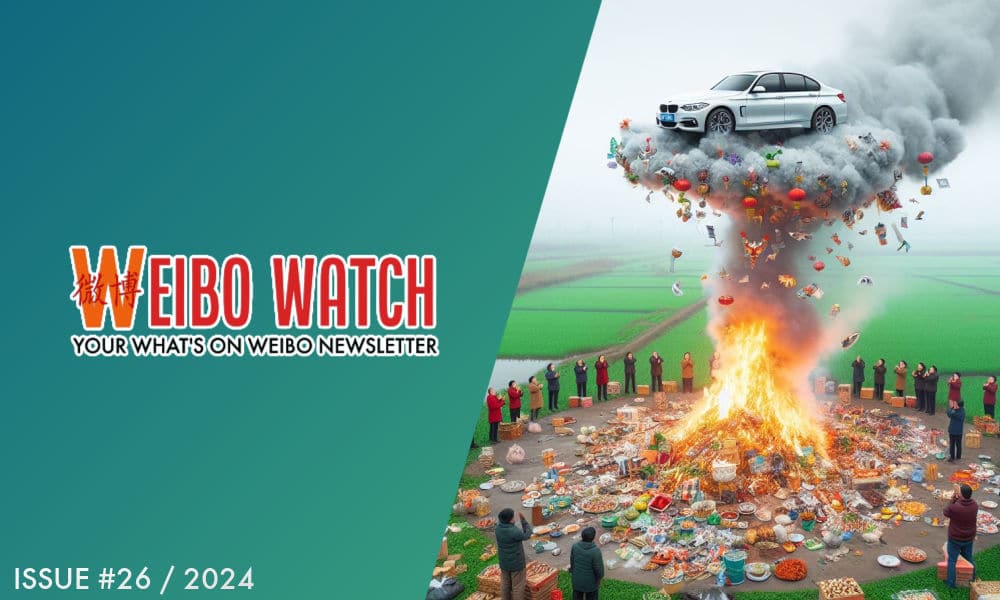
PREMIUM NEWSLETTER | ISSUE #26
This week’s newsletter:
◼︎ 1. Editor’s Note – Burning BMWs
◼︎ 2. What’s Been Trending – A closer look at the featured stories
◼︎ 3. What More to Know – Five bit-sized trends
◼︎ 4. What’s the Drama – Top TV to watch
◼︎ 5. What’s Noteworthy – For Yiwu, the Olympic Games have begun
◼︎ 6. What’s Popular – A Chinese song goes viral on TikTok
◼︎ 7. What’s Memorable – Which language does Ma Ying-jeou speak?
◼︎ 8. Weibo Word of the Week – Nitpicking
Dear Reader,
Expensive watches, cigarettes, jewelry, and liquor – there’s a wide array of offerings for ancestors beyond ‘ghost money’ and food. This week marks China’s Qingming Festival (清明节), also known as Tomb-Sweeping Day, a special time to honor family ancestors by visiting graves, making offerings, and burning spirit money and other paper tributes.
In this age of e-commerce, the ancient ritual of paper offerings has undergone some changes, becoming more diverse and extravagant. Thanks to platforms like Taobao, people now have instant access to a variety of ritual paper gifts. By burning them, it’s believed these offerings are sent to the afterlife, hopefully pleasing the ancestors.
As symbols of power and status evolve, gold and silver paper alone are no longer enough in the 21st century. Nowadays, one can purchase paper replicas of golden credit cards, iPhones, smartwatches, massage chairs, designer bags, rice cookers, furniture, air conditioners, refrigerators, bodyguard ‘puppets,’ and even BMW cars.
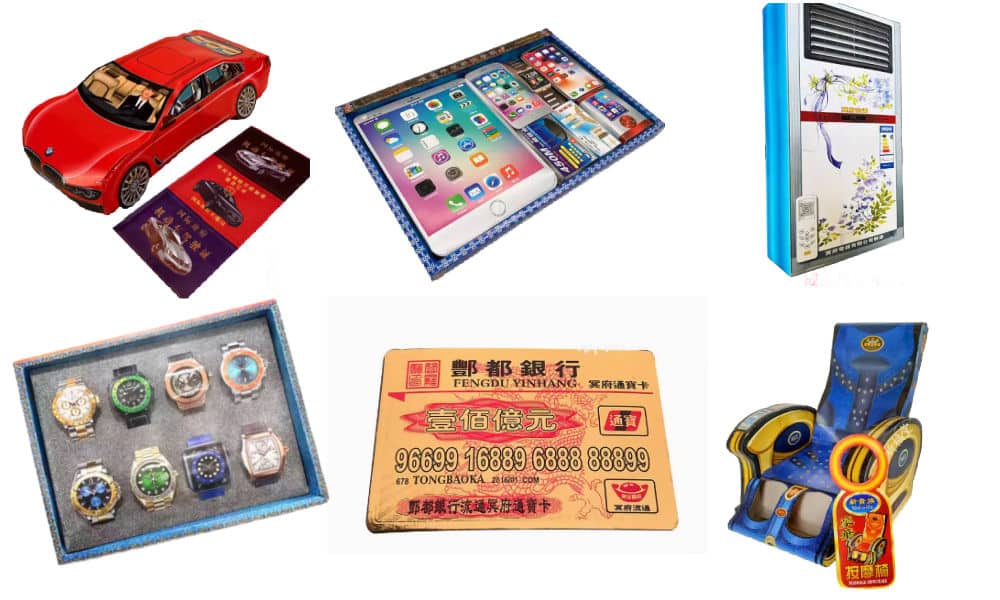
Examples of the various paper offerings available on Taobao: red BMW car, tablets & smartphones, air conditioner, luxury watches, creditcard, massage chair.
Some take it a step further and create entire paper replicas of two-story villas or palaces to honor their ancestors (see video). As many cities already grapple with air quality issues and smog, these customs have sparked discussions for years, with some places prohibiting burning incense and paper during Qingming.
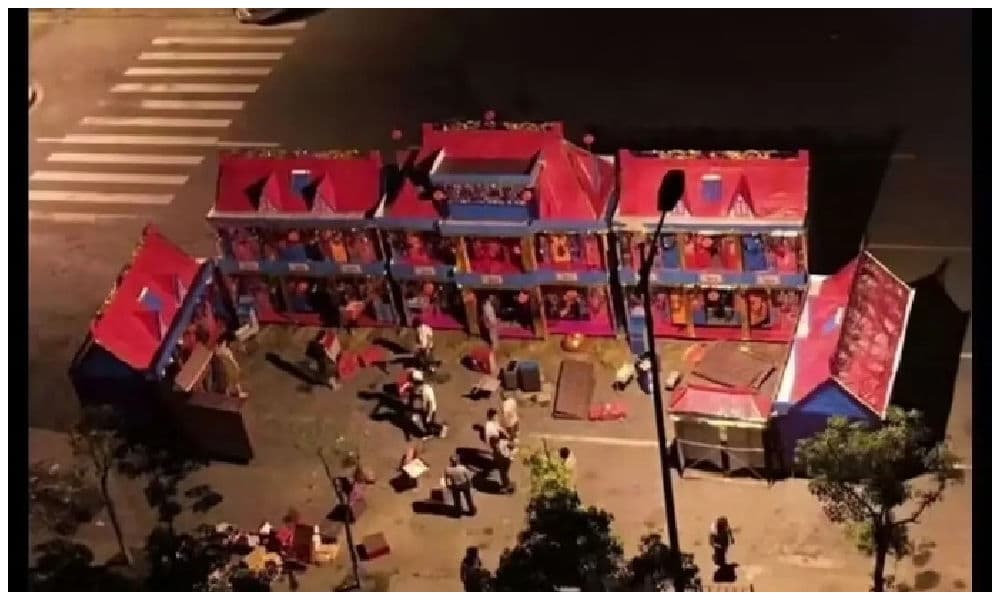
People set up entire paper replicas of two-story villas to honor their ancestors (image circulating on Weibo).
This year, there’s been increased debate surrounding the burning of paper offerings during Qingming. Authorities in Jiangsu’s Nantong, one of China’s fastest-aging cities, recently announced a city-wide ban on the production and sales of paper effigies due to concerns over air pollution and fire safety risks.
The ban has sparked discussions across Chinese social media, particularly because Nantong authorities referred to the custom of burning paper as “feudal superstition” (“封建迷信”).
In China, the practice of making paper replicas of worldly items and ‘sending’ them to deceased family members through fire and smoke is at least a thousand years old. It’s a spiritual aspect of daily life that has become more than tradition alone – it’s deeply ingrained in many families’ lives.1
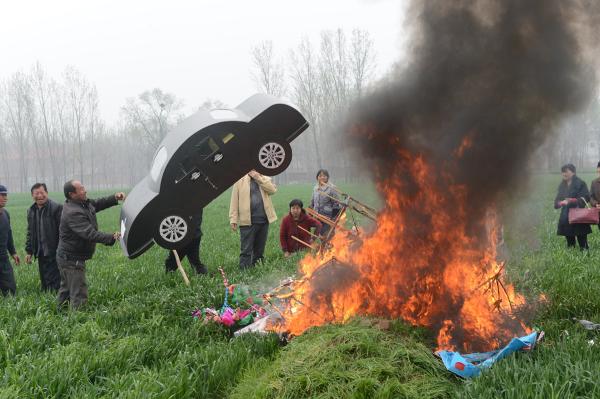
Image by The Paper, 2015: link.
The numerous comments on Weibo this week underscore how significant this topic is for many people. Some threads received over 179,000 likes and over 11,000 replies.
Although opinions vary, it’s evident that most people feel Nantong’s ban was too stringent and that they should be more cautious about banning centuries-old traditions. Some sarcastic comments suggest if they care so much about safety, they should focus more on food regulations instead.
Others note that the city has many Christian churches where people can honor their religion as they please, and that Chinese traditional folk beliefs should not be diminished or looked down upon compared to these Western-based religions.
The popular Weibo account “Xu Ji Observation” (@徐记观察), known for promoting positive online content and the “mass line,” suggested that while the practice of burning entire paper houses reaching two stories high should be abandoned, there should still be room for people to burn smaller paper offerings. There shouldn’t be a “one-size-fits-all approach,” they wrote.
Every year, hundreds of tons of paper are burned in Chinese cities. Besides the billions of yuan spent on paper itself, there are also considerable costs in terms of time and labor to clean up the ash piles.
Ultimately, the question revolves around what is considered ‘extravagant,’ ‘silly,’ or ‘superstitious,’ and where the line is drawn between tradition and absurdity. Some draw the line at anything taller than one story. Others believe anything beyond paper money alone is unnecessarily harmful to the environment, and everyone burning paper items should consider the negative impact.
What’s striking about these discussions is that while they focus on things literally going up in smoke, they also reflect on the world around us. After all, when people are driving around in huge SUVs, consuming plastics, wasting water, constantly buying new gadgets and laptops, and indulging in fast fashion, it seems odd to fuss over sacrificing a paper car for a beloved grandparent. In the end, we’re all burning BMWs in our own different ways. These discussions about where we draw the line, whether in our current world or in our rituals for the afterlife, will only become more prominent over time.
Despite all the discussions and controversy surrounding this Qingming festival, Nantong’s ban has been upheld. Officials argue that instead of elaborate paper items like puppets, purses, and palaces, ancestors would be just as pleased with flowers on their graves. Though less flashy, it’s much better for the environment.
Best,
Manya (@manyapan)
What’s Been Trending
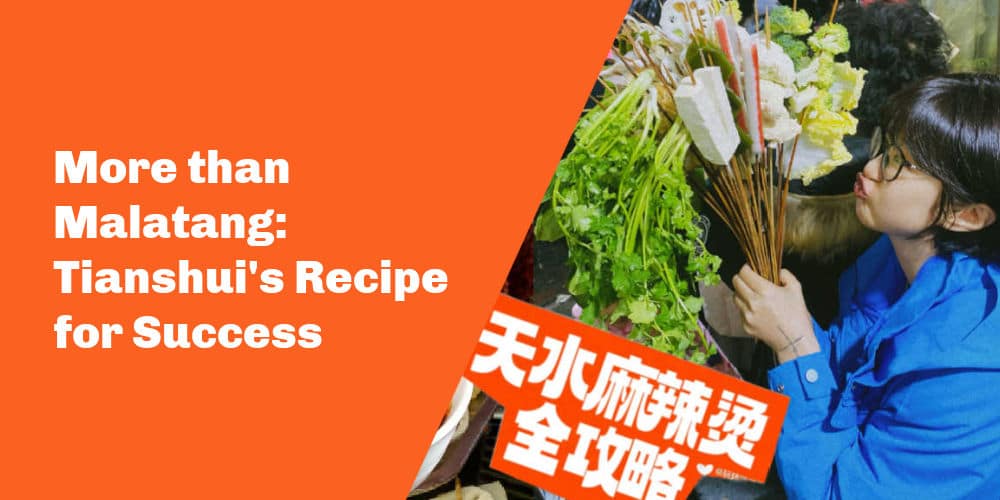
1: China’s New City Marketing | Since the early post-pandemic days, Chinese cities have stepped up their game to attract more tourists. The dynamics of Chinese social media make it possible for smaller, lesser-known destinations to gain overnight fame as a ‘celebrity city.’ Now, it’s Tianshui’s turn to shine with its special take on malatang. City marketing in China will never be the same again. Read all about it here👇🏼

2: Micro Drama, Major Profit | Closely intertwined with the Chinese social media landscape and the fast-paced online entertainment scene, micro dramas have emerged as an immensely popular way to enjoy dramas in bite-sized portions. With their short-format style, these dramas have become big business, leading Chinese production studios to compete and rush to create the next ‘mini’ hit.
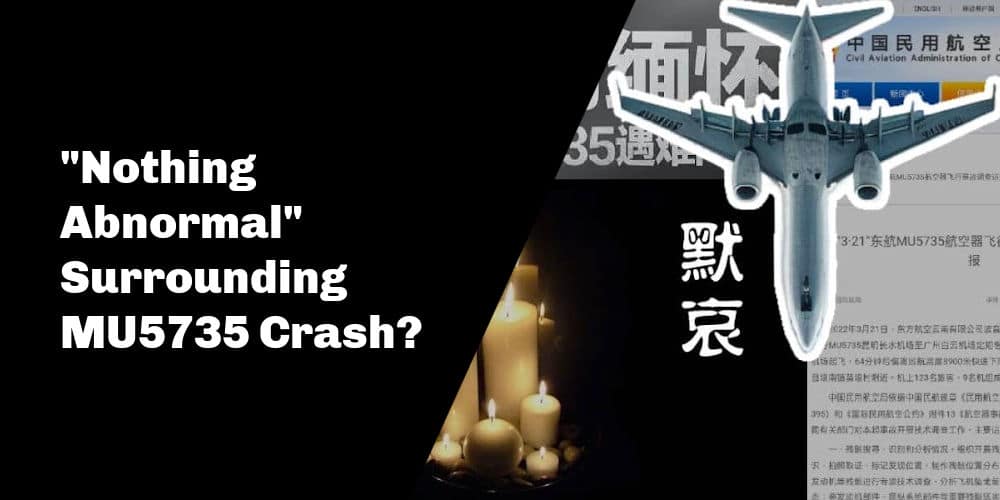
3: Bolt from the Blue | Two years after the tragic crash of MU5735, a new report on the ongoing investigation into the cause of the plane crash has been released. According to China’s Civil Aviation Administration, the report has found “no abnormalities” in the circumstances surrounding the MU5735 incident. Even after two years since the plane nosedived mid-air, people are still awaiting clear answers on what caused the devastating crash in Guangxi, which claimed the lives of all 132 people on board.
What More to Know
◼︎ ⛑️ Taiwan Earthquake | After the 7.3-magnitude earthquake struck the east coast of Taiwan on April 3, expressions of solidarity and support for “our Taiwan compatriots” flooded Chinese social media. However, amidst these sentiments, there were also instances of people mocking the disaster, which claimed the lives of at least 9 people and left over 1000 injured. Weibo management cautioned users against posting content that “lacked empathy” in the wake of the devastating earthquake. Following the quake, Beijing’s Taiwan Affairs Office of the State Council promptly offered disaster assistance, but Taiwan’s Mainland Affairs Council declined, stating that assistance was unnecessary. However, the decision by the Taipei government to accept Japan’s aid, specifically for using hi-tech equipment to detect signs of life, was criticized by netizens. Some nationalistic bloggers even commented that this would be an opportune time to “reunify with the motherland.”
◼︎ 😢 Ma Ying-Jeou’s ‘Voyage of Trust’ | At the invitation of Beijing, former Taiwanese President Ma Ying-jeou is currently visiting the Chinese mainland. His 11-day trip to China began last Monday. It is anticipated that he will also hold a meeting with Chinese leader Xi Jinping next week. Accompanying Ma on this visit is a group of Taiwanese students, and the focus is on cultural exchange, labeled as ‘a voyage of trust.’ Last year, Ma made history as the first former Taiwanese leader to visit China. Given the escalating tensions over Taiwan’s status, his current visit holds particular significance. Serving as president from 2008 to 2016, Ma emphasizes peace and connectivity, according to his own statements. On Chinese social media, there’s much discussion about Ma’s tendency to become emotional quickly. He shed tears last year while visiting his family’s grave in Hunan, and this year, he displayed his emotional side on multiple occasions once again. Some people believe it’s inappropriate for a (former) leader to be so emotionally expressive. As one Weibo blogger questioned, “Ma Ying-jeou cries from dawn till night, from night till dawn. Can crying bring about the reunification with Taiwan?”
◼︎ 🥀 Chongqing Mother Kills Toddler Son | A video circulating on Chinese social media this week has shocked viewers, depicting a 37-year-old mother throwing her 3-year-old son out of a window from a 22nd-floor apartment in Chongqing’s Banan District. The tragic incident occurred on the morning of April 1st. Police reports indicate that prior to this, the woman also attacked her mother-in-law with a knife. While investigations are ongoing, there is speculation online regarding the mother’s mental state. Commentator Hu Xijin emphasized in a recent column the urgent need for increased awareness and support for mental health issues, stressing that it could be a matter of life or death. This case also evokes memories of the “Chongqing Siblings’ Falling Case” (重庆姐弟坠亡案) in 2020, where two siblings (a girl, 2, and a boy, 1) from Chongqing were killed after being thrown from a high-rise apartment window on the 15th floor. Their father and his girlfriend, who allegedly couldn’t accept the children from his previous marriage, were both sentenced to death for their crime and executed on January 31st of this year by lethal injection.
◼︎ 🎬 Oppenheimer in Japan | Japanese filmgoers’ mixed and emotional reactions to the American Oscar-winning movie “Oppenheimer” sparked discussions on Chinese social media this week. The movie finally hit Japanese cinemas on March 29, eight months after its initial premiere, which drew controversy in Japan due to the humorous marketing of the film alongside the release of Barbie (which led to the creation of the ‘Barbenheimer’ meme). The movie centers around the American ‘father of the atom bomb,’ Oppenheimer, and the events leading to the devastating bombing of Hiroshima and Nagasaki. It has faced criticism in Japan for being America-centric and failing to fully depict the horror of nuclear weapons. Chinese netizens showed little understanding for the mixed feelings about the movie in Japan. With the history of the Sino-Japanese War still very much alive in China today, some people wonder why many Japanese people do not have “mixed feelings” about paying respect to the war dead at the Tokyo Yasukuni Shrine. “They’re playing the victim again,” various commenters wrote. (For Dutch-speaking readers, I discussed this topic on Dutch Radio 1; listen to the interview here.)
◼︎ 🇺🇸 Yellen Again | U.S. Treasury Secretary Janet Yellen is visiting China for the second time since summer this week, from April 4th to 9th. Yellen’s itinerary includes meetings with top Chinese officials in both Guangzhou and Beijing, aiming to address ongoing bilateral tensions and manage trade relations between the two countries. Apart from engagements with officials, Yellen will also meet with students and business leaders during her visit. This trip follows a recent phone call between President Biden and Chinese leader Xi Jinping. While many social media discussions focus on the key topics of Yellen’s visit, there is also curiosity among netizens about whether or not she will eat ‘magic mushrooms’ again during this trip. At the time of Yellen’s last visit in 2023, she went viral for dining at a Yunnan restaurant in Beijing, where she was served mushrooms that had hallucinogenic properties (read here).
What’s the Drama

Given the current surge in popularity of Chinese short dramas, let’s introduce you to one of the hottest mini series of the moment: “Fortune Writer” (执笔, zhíbǐ) [“Writing”]. It’s a fantasy costume drama centered around Su Yunqi (苏云绮), who discovers she’s the villainous female lead in a novel—no happy endings for her. Unwilling to accept her fate, Su embarks on a mission to rewrite her life. Released on March 20, this short drama has a total of 24 episodes lasting about 15 minutes each—slightly longer than other popular ‘micro-dramas,’ some of which are only 2-3 minutes per episode nowadays.
Noteworthy:
▶️ This drama’s script is adapted from a series of stories shared on Zhihu’s short story platform, Yanyan Gushi (知乎盐言故事), by the author Lin Yannian (林言年), who also directed the drama.
▶️ In addition to the micro-drama and short story, there is also a podcast available, so fans of this series can enjoy reading, watching, and listening.
▶️ The widespread acclaim for “Fortune Writer” is seen as a sign that the Yanyan Gushi short story app might just be the next goldmine for the Chinese drama and film industry, as short story dramatization is becoming increasingly popular. To date, nearly a hundred stories or series published on Yanyan Gushi have been authorized for film and television adaptations.
You can watch Fortune Writer online here (no English subtitles), or on WeTV here with English subtitles.
What’s Noteworthy

The countdown to the Summer Olympic Games in Paris has begun. Even though we still have some 112 days to go before July 26, there is one city in China that is already fully immersed in the Olympic atmosphere. That city is Yiwu in Zhejiang province, where local companies have already exported $76 million worth of Olympic-related products to France within an eight-week timeframe. From shirts, scarves, and caps for sports fans to trophies and medals for athletes, Yiwu is manufacturing a diverse array of clothing, fan accessories, and other Olympic merchandise. Local businesses are currently operating at full capacity, with many working overtime to fulfill orders.
Yiwu, Zhejiang, is renowned as China’s largest “small commodities city” and, with its expansive International Trade City, serves as the global hub for Christmas merchandise. Following a report by CCTV on Yiwu’s soaring Olympic-related export sales, netizens have expressed pride in Yiwu’s entrepreneurial spirit: “I really admire the people of Yiwu for how fast they are in seizing business opportunities. Time and time again, they make accurate predictions and receive massive orders. Regardless of where the Olympics are held, it’s always Yiwu laughing all the way to the bank!” Others remarked, “We’re an export country, after all.”
What’s Popular
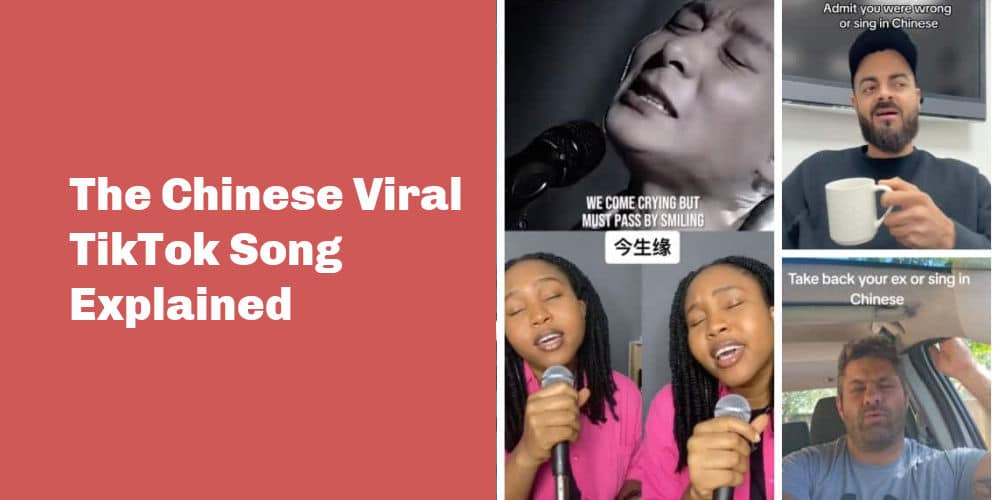
If you’re an avid TikTok user, you’ve likely come across numerous videos of users lip-syncing to a Chinese song. The song, titled “This Life’s Fate” (今生缘), has evolved into a social media challenge where TikTokers strive to deliver a flawless performance without necessarily understanding its meaning (watch video here). If you’re curious to learn more about the song behind this trend and what it actually means, continue reading here 👇.
What’s Memorable

This pick from our archive takes us back to last year’s trip to the mainland by former Taiwan leader Ma Ying-jeou. One aspect of his trip received relatively little attention in the media, even though it generated some buzz among Chinese netizens: Ma’s way of speaking Chinese. What language did he use during his 10-minute speech at Hunan University and while he was paying repects at the graves of his ancestors? Jin Luo explains.👇
Weibo Word of the Week

“Flashlight Evaluation” | Our Weibo Word of the Week is “Flashlight Damage Assessment” or “Portable Lamp Property” (tídēng dìngsǔn 提灯定损), shortened to “Flashlight Evaluation”, a term recently coined by Chinese netizens in response to a story where a landlord conducted a post-lease property inspection by carrying around a large lamp, meticulously shining it into every corner and inspecting every inch of the apartment.
In this context, “Flashlight Evaluation” actually means ‘nitpicking’.
The incident that gave rise to this term went viral on March 28, 2024, after a woman from Shangrao’s Yushan County posted a 10-minute video depicting her landlord inspecting the apartment for damage using a large portable lamp as she prepared to move out. After scrutinizing the property, which the landlord himself constructed, he reportedly compiled a list of all the (minor) damages he found and demanded over 10,000 yuan ($1380) in compensation from the tenant – a substantial sum, particularly considering the monthly rent was only 1200 yuan ($165) and the tenant resided there for just 22 days.
Following the incident’s online explosion, local authorities in Yushan County established an investigation team to probe the matter. According to the latest reports, the landlord has now refunded the tenant’s money. On top of that, he has been detained for throwing bricks at people. I bet he’s fun at parties.
This is an on-site version of the Weibo Watch newsletter by What’s on Weibo. Missed last week’s newsletter? Find it here. If you are already subscribed to What’s on Weibo but are not yet receiving this newsletter in your inbox, please contact us directly to let us know.
Manya is the founder and editor-in-chief of What's on Weibo, offering independent analysis of social trends, online media, and digital culture in China for over a decade. Subscribe to gain access to content, including the Weibo Watch newsletter, which provides deeper insights into the China trends that matter. More about Manya at manyakoetse.com or follow on X.
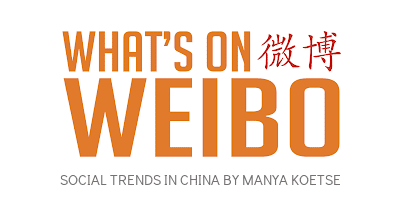
You may like
China ACG Culture
A Very Short Guide to China’s Most Popular Designer Toys
Published
1 week agoon
July 6, 2025
In our last article, we’ve determined how Wakuku’s rise is not just about copying & following in Labubu’s footsteps and more about how China is setting the pace for global pop culture IPs. I now want to give you a small peek into the main characters in the field that are currently relevant.
Even if these dolls aren’t really your thing, you’ll inevitably run into them and everything happening around them.
Before diving into the top trending characters, a quick word on the challenges ahead for Labubu & co:
🚩 Bloomberg Opinion columnist Shuli Ren recently argued that Labubu’s biggest threat isn’t competition from Wakuku or knockoffs like “Lafufu,” but the fragility of its resale ecosystem — particularly how POP MART balances supply, scarcity, and reseller control.
Scarcity is part of what makes Labubu feel premium. But if too many dolls go to scalpers, it alienates real fans. If scalpers can’t profit, Labubu risks losing its luxury edge. Managing this dynamic may be POP MART’s greatest long-term challenge.
🚩 Chinese Gen Z consumers value authenticity — and that’s something money can’t manufacture. If China’s booming IP toy industry prioritizes speed and profit over soul, the hype may die out at a certain point.
🚩 The same goes for storytelling. Characters need a solid universe to grow in. Labubu had years to build out its fantasy universe. Cute alone isn’t enough — characterless toys don’t leave a lasting impression and don’t resonate with consumers.

Examples of popularity rankings of Chinese IP toys on Xiaohongshu.
With that in mind… let’s meet the main players.
On platforms like Xiaohongshu, Douyin, and Weibo, users regularly rank the hottest collectible IPs. Based on those rankings, here’s a quick who’s-who of China’s current trend toy universe:

1. Labubu (拉布布)
Brand: POP MART
Creator: Kasing Lung
Year launched: 2015 (independent), 2019 with POP MART.
The undisputed icon of China’s trend toy world, Labubu is a mischievous Nordic forest troll with big eyes, nine pointy teeth, and bunny ears. Its quirky, ugly-cute design, endless possibilities of DIY costume changes, and viral celebrity endorsements have made it a must-have collectible and a global pop culture phenomenon.

2. Wakuku (哇库库)
Brand & Creator: Letsvan, backed by QuantaSing Group
Year launched: 2024 with first blind box
Wakuku, a “tribal jungle hunter” with a cheeky grin and unibrow, is seen as the rising star in China’s trend toy market. Wakuku’s rapid rise is fueled by celebrity marketing, pop-up launches, and its strong appeal among Gen Z, especially considering Wakuku is more affordable than Labubu.

3. Molly (茉莉)
Brand: POP MART
Designer: Kenny Wong (王信明)
Year launched: 2006 (creator concept); POP MART 2014, first blind boxes in 2016
Molly is a classic trend toy IP, one of POP MART’s favorites, with a massive fanbase and long-lasting popularity. The character was allegedly inspired by a chance encounter with a determined young kid at a charity fundraiser event, after which Kenny Wong created Molly as a blue-eyed girl with short hair, a bit of a temperament, and an iconic pouting expression that never leaves her face.

4. SKULLPANDA (骷髅熊猫)
Brand: POP MART
Creator: Chinese designer Xiong Miao
Year launched: 2018 (creator concept); POP MART 2020
Skullpanda is one of POP MART’s flagship IPs —it’s a goth-inspired fantasy design. According to POP MART, SKULLPANDA journeys through different worlds, taking on various personas and living out myriad lives. On this grand adventure, it’s on a quest to find its truest self and break new ground all while contemplating the shape of infinity.
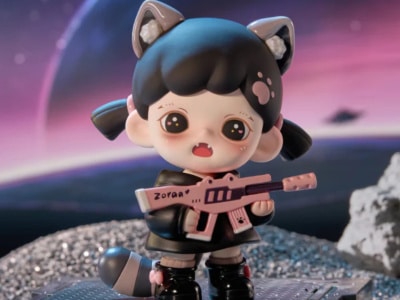
5. Baby Zoraa
Brand: TNT SPACE
Creator: Wang Zequn, CEO of TNT SPACE
Year launched: 2022, same year as company launch
Baby Zoraa is cute yet devlish fierce and is one of the most popular IPs under TNT SPACE. Baby Zoraa is the sister of Boy Rayan, another popular character under the same brand. Baby Zoraa’s first blind box edition reached #1 on Tmall’s trend toy sales charts and sold over 500,000 units.

6. Dora (大表姐)
Brand: TNT SPACE
Year Launched: 2023
Dora is a cool, rebellious “big sister” figure, instantly recognizable for her bold attitude and expressive style. She’s a Gen Z favorite for her gender-fluid, empowering persona, and became a breakout sucess under TNT when it launched its bigger blind boxes in 2023.

7. Twinkle Twinkle [Star Man] (星星人)
Brand: POP MART
Creator: Illustrators Daxin and Ali
Year launched: In 2024 with POP MART
This character has recently skyrocketed in popularity as a “healing star character” inspired by how stars shine even in darkness. POP MART markets this character as being full of innocence and fantasy to provide some relaxation in this modern society full of busyness and pressure.

8. Hirono (小野)
Brand: POP MART
Creator: Lang
Year launched: In 2024 with POP MART
This freckled, perpetually grumpy boy has a wild spirit combining introversion and playful defiance. Hirono highlights the subtle fluctuations of life, its ups and downs, incorporating joy, sadness, fear, and more – a personification of profound human emotions.

9. Crybaby (哭娃)
Brand: POP MART
Creator: Thai artist Molly Yllom (aka Nisa “Mod” Srikamdee)
Year launched: 2017 (creator concept), 2023 POP MART launch
Like Wakuku, Crybaby suddenly went from a niche IP to a new hot trend toy in 2025. Together with Wakuku, it is called the “next Labubu.” Thai artist Molly Yllom created the character after the loss of her beloved dog. Crybaby is a symbol of emotional expression, particularly the idea that it’s okay to cry and express feelings.

10. Pouka Pouka (波卡波卡)
Brand: 52TOYS
Creator: Ma Xiaoben
Year launched: 2025
With its round, chubby face, squirrel cheeks, playful smile, and soft, comforting appearance, Pouka Pouka aims to evoke feelings of warmth, healing, and emotional comfort.
Other characters to watch: CiciLu, Panda Roll (胖哒幼), NANCI (囡茜), FARMER BOB (农夫鲍勃), Rayan, Ozai (哦崽), Lulu the Piggy (LuLu猪), Pucky (毕奇).
We’re still working on this list!
By Manya Koetse
(follow on X, LinkedIn, or Instagram)
Spotted a mistake or want to add something? Please let us know in comments below or email us. First-time commenters, please be patient – we will have to manually approve your comment before it appears.
©2025 Whatsonweibo. All rights reserved. Do not reproduce our content without permission – you can contact us at info@whatsonweibo.com.
China ACG Culture
The Next Labubu: What the Rise of Wakuku Tells Us About China’s Collectible Toy Wave
From ugly-cute rebellion to a new kind of ‘C-pop,’ the breakout success of Wakuku sheds light on Chinese consumer culture and the forces driving China’s trend toy industry.
Published
1 week agoon
July 6, 2025
Wakuku is the most talked-about newcomer in China’s trend toy market. Besides its mischievous grin, what’s perhaps most noteworthy is how closely Wakuku follows the marketing success of Labubu. As the strongest new designer toy of 2025, Wakuku says a lot about China’s current creative economy — from youth-led consumer trends to hybrid business models.
As it is becoming increasingly clear that Chinese designer toy Labubu has basically conquered the world, it’s already time for the next made-in-China collectible toy to start trending on Chinese social media.
Now, the name that’s trending is Wakuku, a Chinese trend toy created by the Shenzhen-based company Letsvan.
In March 2025, a new panda-inspired Wakuku debuted at Miniso Land in Beijing, immediately breaking records and boosting overall store revenue by over 90%. Wakuku also broke daily sales records on May 17 with the launch of its “Fox-and-Bunny” collab at Miniso flagship stores in Shanghai and Nanjing. At the opening of the Miniso Space in Nanjing on June 18, another Wakuku figure sold out within just two hours. Over the past week, Wakuku went trending on Chinese social media multiple times.

From left to right: the March, May, and June successful Wakuku series/figurines
Like Labubu, Wakuku is a collectible keychain doll with a soft vinyl face and a plush body. These designer toys are especially popular among Chinese Gen Z female consumers, who use them as fashion accessories (hanging them from bags) or as desk companions.
We previously wrote in depth about the birth of Labubu, its launch by the Chinese POP MART (founded 2010), and the recipe for its global popularity in this article, so if you’re new to this trend of Chinese designer toys, you’ll want to check it out first (link).
Labubu has been making international headlines for months now, with the hype reaching a new peak when a human-sized Labubu sold for a record 1.08 million RMB (US$150,700), followed by a special edition that was purchased for nearly 760,000 RMB (US$106,000).
Now, Wakuku is the new kid on the block, and while it took Labubu nine years to win over young Chinese consumers, it barely took Wakuku a year — the character was created in 2022–2023, made its retail debut in 2024, and went viral within months.
Its pricing is affordable (59–159 RMB, around $8.2-$22) and some netizens argue it’s more quality for money.
While Labubu is a Nordic forest elf, Wakuku is a tribal jungle warrior. It comes in various designs and colors depending on the series and is sold in blind boxes (盲盒), meaning buyers don’t know exactly which design they’re getting — which adds an element of surprise.
➡️ There’s a lot to say about Wakuku, but perhaps the most noteworthy aspect is how closely it mirrors the trajectory of POP MART’s Labubu.
Wakuku’s recent success in China highlights the growing appeal and rapid rise of Chinese IPs (beyond its legal “intellectual property” meaning, ‘IPs’ is used to refer to unique cultural brands, characters, or stories that can be developed into collectibles, merchandise, and broader pop culture phenomena).
Although many critics predict that the Labubu trend will blow over soon, the popularity of Wakuku and other Labubu-like newcomers shows that these toys are not just a fleeting craze, but a cultural phenomenon that reflects the mindset of young Chinese consumers, China’s cross-industry business dynamics, and the global rise of a new kind of ‘C-pop.’
Wakuku: A Cheeky Jungle Copycat
When I say that Wakuku follows POP MART’s path almost exactly, I’m not exaggerating. Wakuku may be portrayed as a wild jungle child, but it’s definitely also a copycat.
It uses the same materials as Labubu (soft vinyl + plush), the name follows the same ABB format (Labubu, Wakuku, and the panda-themed Wakuku Pangdada), and the character story is built on a similar fantasy universe.
In fact, Letsvan’s very existence is tied to POP MART’s rise — the company was only founded in 2020, the same year POP MART, then already a decade old, went public on the Hong Kong Stock Exchange and became a dominant industry force.
In terms of marketing, Wakuku imitates POP MART’s strategy: blind boxes, well-timed viral drops, limited-edition tactics, and immersive retail environments.
It even follows a similar international expansion model as POP MART, turning Thailand into its first stop (出海首站) — not just because of its cultural proximity and flourishing Gen Z social media market, but also because Thailand was one of the first and most successful foreign markets for Labubu.
Its success is also deeply linked to celebrity endorsement. Just as Labubu gained global traction with icons like BLACKPINK’s Lisa and Rihanna seen holding the doll, Wakuku too leans heavily on celebrity visibility and entertainment culture.
Like Labubu, Wakuku even launched its own Wakuku theme song.
Since 2024, Letsvan has partnered with Yuehua Entertainment (乐华娱乐) — one of China’s leading talent agencies — to tap into its entertainment resources and celebrity network, powering the Wakuku marketing engine. Since stars like Esther Yu (虞书欣) were spotted wearing Wakuku as a jeans hanger, demand for the doll skyrocketed. Yuehua’s founder, Du Hua (杜华), even gifted a Wakuku to David Beckham as part of its celebrity strategy.

From Beckham to Esther Yu; celebrity endorsements play a big role in the viral marketing of Wakuku.
But what’s most important in Wakuku’s success — and how it builds on Labubu — is that it fully embraces the ugly-cute (丑萌 chǒu méng) aesthetic. Wakuku has a mischievous smile, expressive eyes, a slightly crooked face, a unibrow, and freckles — fitting perfectly with what many young Chinese consumers love: expressive, anti-perfectionist characters (反精致).
“Ugly-Cute” as an Aesthetic Rebellion
Letsvan is clearly riding the wave of “ugly trend toys” (丑萌潮玩) that POP MART spent years cultivating.
🔍 Why are Chinese youth so obsessed with things that look quirky or ugly?
A recent article by the Beijing Science Center (北京科学中心) highlights how “ugly-cute” toys like Labubu and Wakuku deviate from traditional Chinese aesthetics, and reflect a deeper generational pushback against perfection and societal expectations.
The pressure young people face — in education, at work, from family expectations, and information overload — is a red thread running through how China’s Gen Z behaves as a social media user and consumer (also see the last newsletter on nostalgia core).
To cope with daily stress, many turn to softer forms of resistance, such as the “lying flat” movement or the sluggish “rat lifestyle” in which people reject societal pressures to succeed, choosing instead to do the bare minimum and live simply.
This generational pushback also extends to traditional norms around marriage, gender roles, and ideals of beauty. Designer toys like Labubu and Wakuku are quirky, asymmetrical, gender-fluid, rebellious, and reflect a broader cultural shift: a playful rejection of conformity and a celebration of personal expression, authenticity, and self-acceptance.

Another popular designer toy is Crybaby, designed by Thai designer Molly, and described as follows: “Crybaby is not a boy or a girl, it is not even just human, it represents an emotion that comes from deep within. It can be anything and everything! Laughter isn’t the only way to make you feel better, crying can be healing too. If one day, a smile can’t alleviate your problems, baby, let’s cry together.”
But this isn’t just about rejecting tradition. It’s also about seeking happiness, comfort, and surprise: emotional value. And it’s usually not brand-focused but influencer-led. What matters is the story around it and who recommends it (unless the brand becomes the influencer itself — which is what’s ultimately happening with POP MART).
One of the unofficial ambassadors of the chǒu méng ugly-cute trend is Quan Hongchan (全红婵), the teenage diving champion and Olympic gold medallist from Guangdong. Quan is beloved not just for her talent, but also for her playful, down-to-earth personality.
During the Paris Olympics, she went viral for her backpack, which was overflowing with stuffed animals (some joked she was “carrying a zoo on her back”) — and for her animal-themed slippers, including a pair of ugly fish ones.

Quan Hongchan with her Wakuku, and her backpack and slippers during her Paris Olympics days.
It’s no surprise that Quan Hongchan is now also among the celebrities boosting the popularity of the quirky Wakuku.
From Factory to Fandom: A New Kind of “C-pop” in the Making
The success of Wakuku and other similar toys shows that they’re much more than Labubu 2.0; they’re all part of a broader trend tapping into the tastes and values of Chinese youth — which also speaks to a global audience.
And this trend is serious business. POP MART is one of the world’s fastest-growing consumer brands, with a current market value of approximately $43 billion, according to Morgan Stanley.
No wonder everyone wants a piece of the ‘Labubu pie,’ from small vendors to major companies.
It’s not just the resellers of authentic Labubu dolls who are profiting from the trend — so are the sellers of ‘Lafufu,’ a nickname for counterfeit Labubu dolls, that have become ubiquitous on e-commerce platforms and in toy markets (quite literally).
Wakuku’s rapid rise is also a story of calculated imitation. In this case, copying isn’t seen as a flaw but as smart market participation.
The founding team behind Letsvan already had a decade of experience in product design before setting out on their journey to become a major player in China’s popular designer toy and character merchandise market.
But their real breakthrough came in early 2025, when QuantaSing (量子之歌), a leading adult learning ed-tech company with no previous ties to toys, acquired a 61% stake in the company.
With QuantaSing’s financial backing, Yuehua Entertainment’s marketing power, and Miniso’s distribution reach, Wakuku took it to the next level.
The speed and precision with which Letsvan, QuantaSing, and Wakuku moved to monetize a subcultural trend — even before it fully peaked — shows just how advanced China’s trend toy industry has become.
This is no longer just about cute (or ugly-cute) designs; it’s about strategic ecosystems by ‘IP factories,’ from concept and design to manufacturing and distribution, blind-box scarcity tactics, immersive store experiences, and influencer-led viral campaigns — all part of a roadmap that POP MART refined and is now adopted by many others finding their way into this lucrative market. Their success is powered by the strength of China’s industrial & digital infrastructure, along with cross-industry collaboration.
The rise of Chinese designer toy companies reminds of the playbook of K-pop entertainment companies — with tight control over IP creation, strong visual branding, carefully engineered virality, and a deep understanding of fandom culture. (For more on this, see my earlier explanation of the K-pop success formula.)
If K-pop’s global impact is any indication, China’s designer toy IPs are only beginning to show their potential. The ecosystems forming around these products — from factory to fandom — signal that Labubu and Wakuku are just the first wave of a much larger movement.
– By Manya Koetse
Spotted a mistake or want to add something? Please let us know in comments below or email us. First-time commenters, please be patient – we will have to manually approve your comment before it appears.
©2025 Whatsonweibo. All rights reserved. Do not reproduce our content without permission – you can contact us at info@whatsonweibo.com.
Popular Reads
-

 China Society10 months ago
China Society10 months agoDeath of Chinese Female Motorcycle Influencer ‘Shigao ProMax’ Sparks Debate on Risky Rides for Online Attention
-

 China World11 months ago
China World11 months agoChina at Paris 2024 Olympics Trend File: Medals and Moments on Chinese Social Media
-

 China Memes & Viral11 months ago
China Memes & Viral11 months agoTeam China’s 10 Most Meme-Worthy Moments at the 2024 Paris Olympics
-
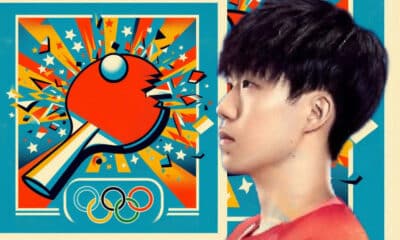
 China Memes & Viral12 months ago
China Memes & Viral12 months agoAbout Wang Chuqin’s Broken Paddle at Paris 2024






